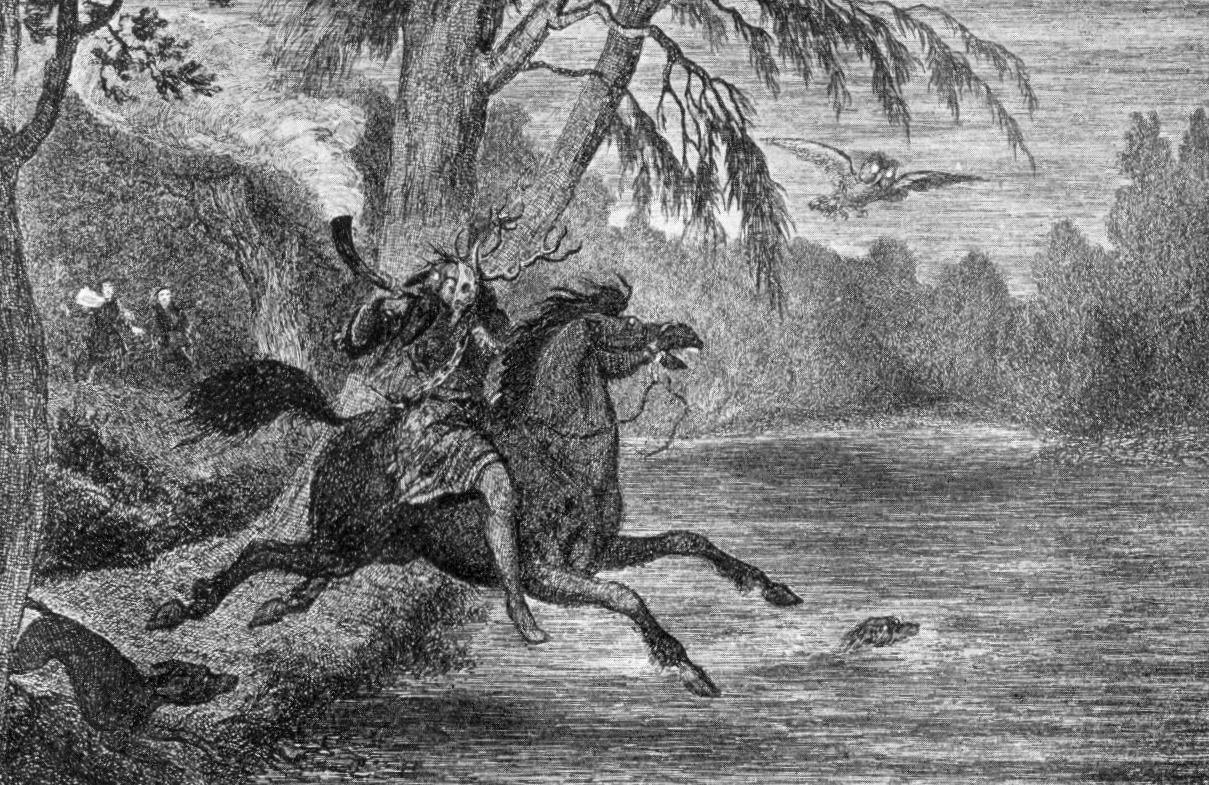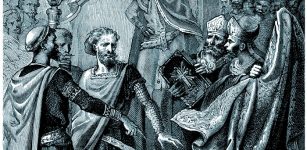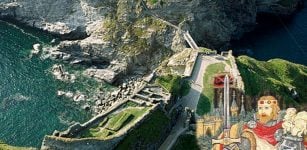Herne The Hunter – The Horned God And Lord Of The Forest In British Mythology
Ellen Lloyd – MessageToEagle.com -Little is known about a mysterious, mythical creature called Herne the Hunter who was said to reside in Windsor Forest and Great Park in the English county of Berkshire.
The original source for many of the tales told of Herne remains unknown. Herne the Hunter was mentioned by William Shakespeare who described him as “a spirit” and “sometime a keeper … in Windsor forest” who is seen to “walk round about an oak, with great ragg’d horns” at midnight during winter-time.
The Merry Wives of Windsor’ : William Shakespeare
‘There is an old tale goes, that Herne the hunter,
Sometime a keeper here in Windsor forest,
Doth all the winter time at still midnight,
Walk around about an oak, with great ragg’d horns;
And there he blasts the tree, and takes the cattle;
And makes milch-kine yield blood, and shakes a chain
In a most hideous and dreadful manner.’
The Merry Wives of Windsor : William Shakespeare
‘Why, yet there want not many, that do fear
In deep of night to walk by this Herne’s oak.’
Herne the Hunter in British Mythology
Is there a true story behind the legend of Herne the Hunter? There are several versions of an old tale revealing the faith of Herne, who was a huntsman employed by King Richard II.
Soon some men became jealous of his status and accused him of poaching on the King’s land. Falsely charged with treason, Herne became an outcast among his former friends. Legend tells that in despair, he hung himself from an oak tree which later became known as Herne’s Oak.
There is also another version of the story. According to which Herne was fatally wounded while saving King Richard from a charging stag. He was miraculously cured by a stranger, who tied the antlers of a dead stag to the dying man’s brow. The stranger demanded in payment all Herne’s skill in venery. Crazed by the loss of that skill in the craft he loved, Herne fled to the forest, and hanged himself, again from the oak tree. However, every night he rides once more leading a spectral hunt, chasing the game of Windsor Forest.
On August 31, 1863, the famous Windsor Oak fell from natural causes but was soon replaced by a new young Oak tree by Queen Victoria on the same spot.
Why was Herne the Hunter called Lord of the Forest?
In the area around Berkshire, Herne is depicted wearing the antlers of a great stag. He is considered a great hunter who possessed divine skills. Herne’s antlers connect him to the deer, which was given a position of great honor. Legends tell that he carried a great horn and a wooden bow, riding a mighty black horse and accompanied by a pack of baying hounds. If someone crossed his path, they were swept up in it, and often taken away, destined to ride with him for eternity.

Encountering Herne the Hunter is a bad omen especially to the royal family. According to local legend, Herne only appears in Windsor Forest when needed, such as in times of national crisis.
Was Herne the Hunter Cernunnos, the Celtic horned god or the Norse god Odin?
There many ancient accounts of people and gods with horns. Horns represent the primal power of nature, express the unstoppable power and the majesty and throughout human history, horns have been synonymous with this strength.
The antlered god Cernunnos, whose cult is most widely attested, is usually represented with the horns of a ram or a deer, squatting on the ground, and his posture indeed recalls that of the Buddha. with a humanoid body in Celtic myth.
There is no one particular myth concerning him, for only his image remains. The ‘cer’ part of his name, relating to his antlers, means ‘horned’. He is found mainly in sculpted statues and reliefs from ancient Gaul (modern France), but the clearest image is found on the silver votive cauldron, the Gundestrup Cauldron, which is described in one of our articles.
See also:
Gundestrup Cauldron: Great Gilded Silver Vessel Decorated With Scenes Derived From Celtic Mythology
‘Fingal’s Cave’ – An Enigmatic Place Shrouded In Mystery And Legend
Pre-Christian Mystery – Stone Figures With Hidden Unexplainable Distant Past
Mystery Of The Banshee – Is The Celtic Death Messenger Linked To The Tuatha De’Dannan Race?
Horned animal deities played a significant role in the early civilizations of the ancient world, where the power and mysteries of the Sumerian bull gods of Sumeria and the Egyptian ram and bull gods were transmitted into the civilizations of the ancient world.

The Windsor Forest area has a heavy Saxon influence. In the Early Middle Ages, Windsor Forest came under the control of the pagan Angles who worshiped their own pantheon of gods, including Woden, who was sometimes depicted as horned, and whose Norse equivalent Odin rode across the night sky with his own Wild Hunt and hanged himself on the world tree Yggdrasil to learn the secret of the runic alphabet. It has been suggested that the name Herne is derived from the title Herian, a title used for Woden in his role as leader of fallen warriors.

Dr. Margaret Alice Murray, (1863-1963), who was a prominent British Egyptologist and anthropologist wrote in her book God of the Witches that Herne is a manifestation of Cernunnos, the Celtic horned god. The fact that existence of Herne the Hunter has only been claimed in Berkshire, and not in the rest of the Windsor Forest area, suggests that Herne should be considered a “localized” god and could indeed be the Berkshire interpretation of Cernunnos.
Written by – Ellen Lloyd – MessageToEagle.com
Copyright © MessageToeagle.com All rights reserved. This material may not be published, broadcast, rewritten or redistributed in whole or part without the express written permission of MessageToeagle.com
Expand for referencesRelated Posts
-
 Celts: Facts And History About The Powerful And Superior People Of Central And Northern Europe
No Comments | Mar 1, 2017
Celts: Facts And History About The Powerful And Superior People Of Central And Northern Europe
No Comments | Mar 1, 2017 -
 Legend Of The Ruthven Barracks Where Alexander Stewart Played Chess With The Devil
No Comments | Feb 1, 2022
Legend Of The Ruthven Barracks Where Alexander Stewart Played Chess With The Devil
No Comments | Feb 1, 2022 -
 Controversial Artifact: What Kind Of Message Does The Phaistos Disk Contain?
No Comments | May 13, 2014
Controversial Artifact: What Kind Of Message Does The Phaistos Disk Contain?
No Comments | May 13, 2014 -
 William The Conqueror: Ruthless And Powerful Ruler That Changed Britain Forever
No Comments | Mar 31, 2023
William The Conqueror: Ruthless And Powerful Ruler That Changed Britain Forever
No Comments | Mar 31, 2023 -
 Was Tintagel Castle A Fortress Used By Iconic Hero King Arthur?
No Comments | Mar 12, 2016
Was Tintagel Castle A Fortress Used By Iconic Hero King Arthur?
No Comments | Mar 12, 2016 -
 Valkyries Sigrdriva And Brynhildr: Brave Warriors Who Were Punished By God Odin In Norse And Germanic Mythology
No Comments | Apr 4, 2017
Valkyries Sigrdriva And Brynhildr: Brave Warriors Who Were Punished By God Odin In Norse And Germanic Mythology
No Comments | Apr 4, 2017 -
 Barbarians Were People Who Didn’t Speak Greek
No Comments | Jan 18, 2016
Barbarians Were People Who Didn’t Speak Greek
No Comments | Jan 18, 2016 -
 Bad And Good Karma Depends On Us – We Are Architects Of Our Own Fate
No Comments | Aug 14, 2018
Bad And Good Karma Depends On Us – We Are Architects Of Our Own Fate
No Comments | Aug 14, 2018 -
 Fantastic Biological Street Lighting: Using Glowing Plants And Trees As An Energy Source
No Comments | Jun 2, 2016
Fantastic Biological Street Lighting: Using Glowing Plants And Trees As An Energy Source
No Comments | Jun 2, 2016 -
 Kudurru Of Melishihu – Stone Records From The Kassite Dynasty In Babylonia
No Comments | Jan 17, 2016
Kudurru Of Melishihu – Stone Records From The Kassite Dynasty In Babylonia
No Comments | Jan 17, 2016

